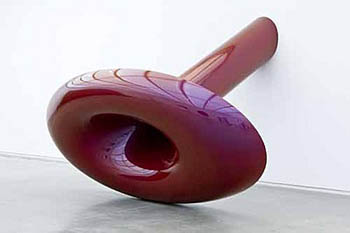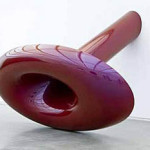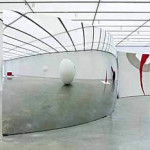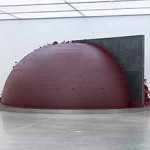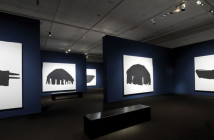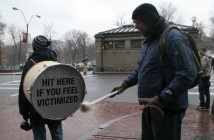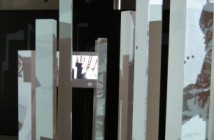ANISH KAPOOR @ THE ICA
Anish Kapoor is an internationally acclaimed sculptor with a unique philosophical agenda. Currently, the Institute of Contemporary Art is featuring an exhibition highlighting the artist’s work entitled Past, Present, Future. Kapoor is best known in the US for his large-scale public art sculptures such as Sky Mirror, a thirty-five foot wide dish made of gleaming, polished steel that was exhibited at Rockefeller Center in New York City, and Cloud Gate, in Chicago's Millennium Park. Although his sculptures are sophisticated and stunning to look at, Kapoor explains that “…being an artist is not about making more or less beautiful things. In the end, truly, who cares? … There are only a few possibilities left; they are poetic, philosophical, and perhaps spiritual.” Kapoor manages to deliver sculptures that speak to the viewer with physical and intellectual depth while still presenting us with stylish designs in an accessible package.
Although Kapoor considers himself a sculptor, he states that he is “…deeply engaged in and interested in some of the problems of painting.” Traditionally, painters create a deep space behind the picture plane by using perspective and shading to create the illusion of a three dimensional world. As a sculptor, Kapoor is already working in three dimensions, but by choosing to work with mirrored surfaces, Kapoor presents us with “…a new kind of space which is, in fact, in front of the picture plane.” By projecting our own distorted reflection, Kapoor creates a dizzying kind of new interactive space that activates the viewer's perception.
One of the highlights of Kapoor’s reflective objects is the S-Curve sculpture in the center of the gallery space. The simple but elegant S-shaped curvature made of thin, polished steel also manages to portray the qualities of a funhouse mirror. While one bend of the sculpture stretches and distorts the viewer’s image, the complimenting arch reflects a more familiar and less contorted likeness. Once the viewer has figured out the complex curves of the reflective surface, they become more conscious of their relationship to the object. They are actually a part of the picture. Also, because of the constantly moving crowd, the piece does not appear the same to any one person at any given moment in time. Therefore the space that it creates is not fixed like it would be in painting—it is interactive and constantly progressing.
Kapoor interacts with the viewer is by exploring the relationship between space and the human body. In My Body Your Body, Kapoor has built a deep, velvety blue recession into the gallery wall. According to Kapoor, “[the]suggestion of the work is that this is an interior into the viewer.” The installation is difficult to decipher. Looking at the work straight on, all the viewer can perceive is darkness. It is necessary to get up close and explore the work from different angles to begin to understand it. Kapoor notes that we, as humans, are comprised of many of these concave forms, which we find both fascinating and uncomfortable. Confronting the unclear boundaries of the artwork addresses the challenging relationship we have to our own bodies, and forces us “…to re-understand our physical relation with space.”
Several of Kapoor’s other sculptures explore the theme of forms and shapes that are in process or evolving. This is another way that he challenges traditional, static sculpture and painting. In Past, Present, Future Kapoor has installed a moving semicircular arch that slowly rotates across a mass of gooey wax and red pigment, defining this immense spherical form. The viewer is experiencing the sculpture in a physical way while it is in the process of forming itself.
Kapoor’s choice of materials is very interesting because this mass of wax and pigment is essentially oil paint. However, instead of arranging this material on a flat canvas, Kapoor presents the juicy red wax as a work of art in itself. The subject is not what we are looking at, but rather why and how it is being made. While the sculptures have an undeniable charm and quality of fun, Kapoor's works are not meant to serve as mere entertainment. His works intersect with concepts of modernism - a dialogue of media, physicality to reflect questions about the conceptual self and our perception of it.
- Anish Kapoor, Inwendig Volle Figur, 2006. Courtesy of the artist and Lisson Gallery. Photo: John Kennard.
- Anish Kapoor, S-Curve, 2006. Courtesy Regen Projects, Los Angeles. Photo: John Kennard
- Anish Kapoor, Past, Present, Future 2006. Courtesy of the artist and Lisson Gallery. Photo: John Kennard.
Institute of Contemporary Art, Boston
"Anish Kapoor: Past, Present, Future" is on view until September 7th, 2008 in the West Gallery of ICA, located at 100 Northern Ave., in Boston, MA
All images are courtesy of the artist, the respective galleries /collections, and the ICA.

